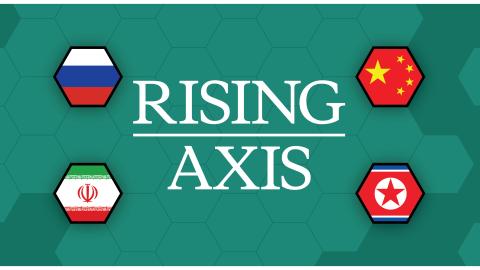Rising Axis showcases the depth of Hudson’s analysis on how America and its allies can compete with and defeat the axis of aggressors.
To receive the newsletter in your inbox, subscribe here.
“As war rages from Bakhmut to Kherson, Vladimir Putin is pursuing a grand strategy aimed at weakening the North Atlantic Treaty Organization’s southern flank in Africa,” wrote Zineb Riboua in an August 2023 op-ed in the Wall Street Journal. Hudson experts John Lee, Thomas J. Duesterberg, and Joshua Meservey have also documented how exploitative programs like the Belt and Road Initiative (BRI) allow China to increase its control over resource-rich nations in Africa and the Pacific, furthering Beijing’s goal of monopolizing key manufacturing sectors.
For too long, American policymakers have ignored Russia’s and China’s expanding footprints in the Global South. To succeed in a new era of great power competition, the United States needs to understand and counter the rising axis of aggressors’ tactics. Learn how below.
Read Riboua’s op-ed, “The Wagner Group in Africa Serves Putin’s Global Ambitions.”
Bottom Line
“The African continent is emerging as a new center of power right before our eyes.”
— Russian President Vladimir Putin
Facts and Analysis
1. China uses both information warfare and predatory assistance programs to grow its influence in Africa and the Pacific.
- China sees many Global South nations as important sources of energy, minerals, agricultural products, and other commodities necessary for sustaining China’s material rise. Former World Bank President David Malpass explains how debt incurred through the BRI—a program designed to broaden Chinese influence around the world, open global markets for China’s booming manufacturing sector, and obtain needed commodity resources for Beijing’s huge economy—has allowed China to grow its influence on the continent.
- Beginning in the Hu period (2002–12), China used aid and other inducements to persuade many developing nations to abandon formal recognition of Taiwan and to support China in reducing Taiwan’s institutional and diplomatic relevance and role. Beijing also banded with many developing nations to resist US and other democracies’ condemnation of human rights abuses.
- China opportunistically frames itself as part of the developing world in solidarity with African states because Beijing believes that the current global order suppresses its own rise to its rightful place as the global hegemon.
2. Russia’s involvement in Africa advances the rising axis’s goals.
- Russia is increasingly asserting itself on the continent. Its Wagner Group, now known as the Russian Expeditionary Corps or Africa Corps, has embedded itself in strategic and lucrative areas in countries like Libya, Mali, and the Central African Republic. Russian disinformation campaigns may also have contributed to the expulsion of French forces from several countries in the Sahel region. This is in addition to increased Russia-Africa trade over the last 15 years, a recent flurry of military agreements, and continued weapons sales.
- “When the West doesn’t answer the call, Wagner does,” writes Riboua. Russia has become many African regimes’ preferred counterterrorism partner. Since 2020, Russia’s aggressive approach has significantly increased violence in the region.
- Prior to the death of Wagner leader Yevgeny Prigozhin, more than 1,000 Russian mercenaries were operating in Mali, 1,200 in Libya, and 1,000 in the Central African Republic. Russia also expanded its economic and political projects to Burkina Faso, Algeria, Sudan, Mozambique, Zimbabwe, and Eritrea.
- The Wagner Group also supplied mercenaries, regime security, profit-sharing deals, media management, and disinformation campaigns to African leaders. Evidence suggests that these activities have continued apace following Prigozhin’s death and the reorganization of Wagner’s forces.
3. The US has options to counter Russia and China in the Global South.
- Reversing these negative trends for US interests will require longer-term reforms to American foreign policy—for instance, reorienting the focus of American engagement in Africa to motivate and facilitate the US private sector’s activity on the continent.
- In Mali, separatist groups—notably the Tuareg rebels known as the Azawad—have managed to repel Wagner forces, preventing the mercenaries from controlling the northern regions of the country. For NATO allies, supporting such groups presents a new option to counter Moscow’s influence and delegitimize Russian presence on the continent.
- The US and its allies should conduct country-specific assessments to understand why an individual leader, government, or nation is making certain strategic and policy decisions. Then, Washington should engage in cognitive warfare and the battle of narratives to compete with China’s information warfare.
- China’s Global South strategy depends heavily on narrative dominance and the use of material offerings to achieve elite capture in targeted countries. Washington needs to more explicitly deploy overseas development assistance (ODA) to influence elite behavior, governance institutions, and norms in the Global South.
- While Washington is making good ground with advanced-economy allies such as Japan, Australia, South Korea, and Taiwan to reduce dependence on Chinese industry, the US needs to strike a considerably different bargain with developing nations—one that is consistent with the political imperative of reinvigorating domestic pillars of national power and wealth.
For more, read John Lee’s report
Understanding and Countering China’s Global South Strategy in the Indo-Pacific.


















